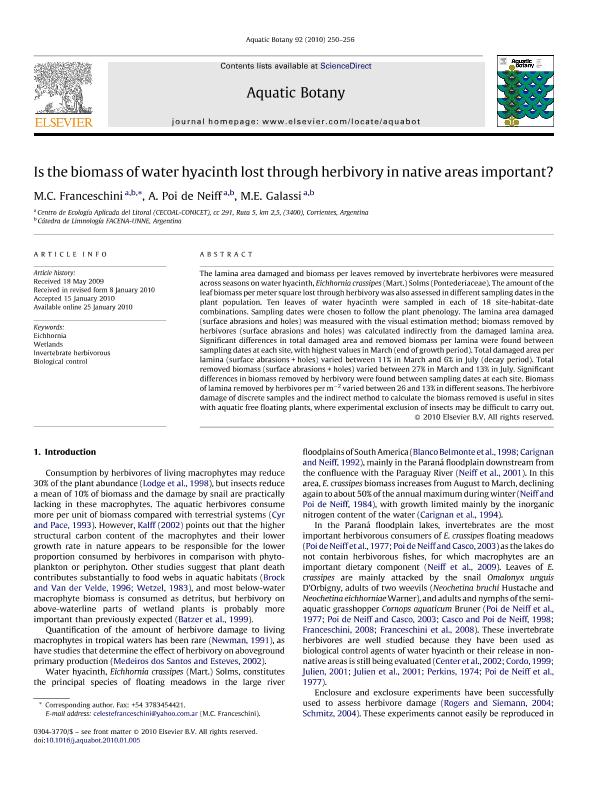Mostrar el registro sencillo del ítem
dc.contributor.author
Franceschini, Maria Celeste

dc.contributor.author
Poi, Alicia Susana G.

dc.contributor.author
Galassi, María Eugenia

dc.date.available
2017-12-14T18:21:08Z
dc.date.issued
2010-05
dc.identifier.citation
Franceschini, Maria Celeste; Poi, Alicia Susana G.; Galassi, María Eugenia; Is the biomass of waterhyacinth lost through herbivory in native areas important?; Elsevier Science; Aquatic Botany; 92; 4; 5-2010; 250-256
dc.identifier.issn
0304-3770
dc.identifier.uri
http://hdl.handle.net/11336/30664
dc.description.abstract
The lamina area damaged and biomass per leaves removed by invertebrate herbivores were measured across seasons on water hyacinth, Eichhornia crassipes (Mart.) Solms (Pontederiaceae). The amount of the leaf biomass permeter square lost through herbivory was also assessed in different sampling dates in the plant population. Ten leaves of water hyacinth were sampled in each of 18 site-habitat-date combinations. Sampling dates were chosen to follow the plant phenology. The lamina area damaged (surface abrasions and holes) was measured with the visual estimation method; biomass removed by herbivores (surface abrasions and holes) was calculated indirectly from the damaged lamina area. Significant differences in total damaged area and removed biomass per lamina were found between sampling dates at each site, with highest values in March (end of growth period). Total damaged area per lamina (surface abrasions + holes) varied between 11% in March and 6% in July (decay period). Total removed biomass (surface abrasions + holes) varied between 27% in March and 13% in July. Significant differences in biomass removed by herbivory were found between sampling dates at each site. Biomass of lamina removed by herbivores perm2 varied between 26 and 13% in different seasons. The herbivore damage of discrete samples and the indirect method to calculate the biomass removed is useful in sites with aquatic free floating plants, where experimental exclusion of insects may be difficult to carry out
dc.format
application/pdf
dc.language.iso
eng
dc.publisher
Elsevier Science

dc.rights
info:eu-repo/semantics/openAccess
dc.rights.uri
https://creativecommons.org/licenses/by-nc-sa/2.5/ar/
dc.subject
Eichhornia
dc.subject
Wetlands
dc.subject
Invertebrate Herbivorous
dc.subject
Biological Control
dc.subject.classification
Otras Ciencias Biológicas

dc.subject.classification
Ciencias Biológicas

dc.subject.classification
CIENCIAS NATURALES Y EXACTAS

dc.title
Is the biomass of waterhyacinth lost through herbivory in native areas important?
dc.type
info:eu-repo/semantics/article
dc.type
info:ar-repo/semantics/artículo
dc.type
info:eu-repo/semantics/publishedVersion
dc.date.updated
2017-12-04T17:34:37Z
dc.journal.volume
92
dc.journal.number
4
dc.journal.pagination
250-256
dc.journal.pais
Países Bajos

dc.journal.ciudad
Amsterdam
dc.description.fil
Fil: Franceschini, Maria Celeste. Consejo Nacional de Investigaciones Científicas y Técnicas. Centro Científico Tecnológico Conicet - Nordeste. Centro de Ecología Aplicada del Litoral. Universidad Nacional del Nordeste. Centro de Ecología Aplicada del Litoral; Argentina
dc.description.fil
Fil: Poi, Alicia Susana G.. Consejo Nacional de Investigaciones Científicas y Técnicas. Centro Científico Tecnológico Conicet - Nordeste. Centro de Ecología Aplicada del Litoral. Universidad Nacional del Nordeste. Centro de Ecología Aplicada del Litoral; Argentina
dc.description.fil
Fil: Galassi, María Eugenia. Consejo Nacional de Investigaciones Científicas y Técnicas. Centro Científico Tecnológico Conicet - Nordeste. Centro de Ecología Aplicada del Litoral. Universidad Nacional del Nordeste. Centro de Ecología Aplicada del Litoral; Argentina
dc.journal.title
Aquatic Botany

dc.relation.alternativeid
info:eu-repo/semantics/altIdentifier/doi/http://dx.doi.org/10.1016/j.aquabot.2010.01.005
dc.relation.alternativeid
info:eu-repo/semantics/altIdentifier/url/http://www.sciencedirect.com/science/article/pii/S0304377010000148
Archivos asociados
